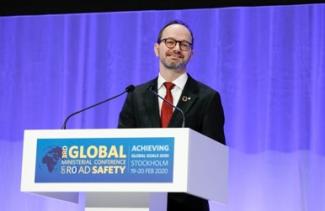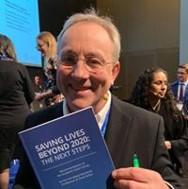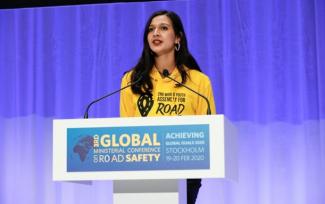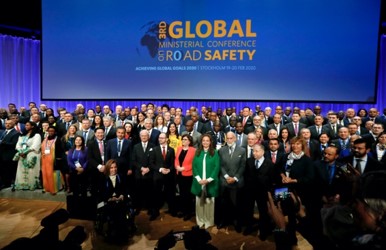The world’s leaders gathered on the global UN conference on road safety
The sense of urgency and distress was felt in the speeches when 1,700 delegates from 140 countries gathered on the third global ministerial conference on road safety in Stockholm February 19-20. The traffic-death- epidemic are by no means under control; traffic accidents are now the leading cause of premature death among children and adolescents in the world. But the result of the conference is still very positive. The global commitment to tackle the problem is stronger than ever and the strategic decisions and documents following the conference are promising and will probably help us move forward with research that contributes to our common global goals.
The purpose of the conference was to evaluate the road safety results from the last decade, also known as The Decade of action, share best practice, discuss and reflect, but also to set the new targets for the upcoming ten years and decide on suitable strategies on how to reach the targets in practice. The Opening Session began with introductory remarks on road safety by His Majesty the King of Sweden Carl XVI Gustaf.
“It is important that we come together and can share knowledge, examples and ideas from around the world to improve road safety," said His Majesty.
The host of the conference, the Swedish Minister for Infrastructure Mr. Tomas Eneroth, welcomed everyone at the opening ceremony.
"We recognize our shared responsibility and call on the Member States to help reduce road fatalities by at least 50 percent from 2020 to 2030," Mr. Tomas Eneroth said.
He continued that a strong political commitment is now needed at all levels, together with regional and national strategies and road safety action plans.
"If we are serious about halving the number of people killed on our roads by 2030, we need a holistic perspective where we include road safety and safe systems as part of our land use, road design,planning of transport systems and management. We know that there are well-known road safety measures with proven impact, which can save 100,000 lives each year, but which have not yet been implemented in most countries".
The Stockholm declaration – the final document set new goals
The outcome of the conference was the Stockholm declaration, that consists of the strategic approach on how to tackle the global sustainability problem of road fatalaties. The Declaration is ambitious and forward-looking and connects road safety to the implementation of the 2030 Agenda for Sustainable Development. The Stockholm Declaration also reflects the nine recommendations "Saving lives beyond 2030", developed by the conference’s Academic Expert Group, led by our adjunct prof. Claes Tingvall.
The next generation demands better road safety
The Stockholm Declaration received applause and approval. But some of the conference’s warmest applause went to Omnia El Omrani, a young medical student from Egypt who represents the World Youth Meeting for Road Safety. Wearing a yellow hoodie, she spoke with commitment and anger about how traffic in developing countries causes many unnecessary deaths when young people are going to school and work.
"We demand safer and more sustainable transport systems now. We no longer tolerate this. Stop killing our genes, we are not statistics, we are your children", said Omnia El Omrani.
Value for vehicle and traffic safety research
The Stockholm declaration and its recommendations will be of great value to road safety research.
“The recommendations are very cleverly structured because they link to other sustainability goals and, therefore, if we really work strategically, will get a good help in meeting our research targets. We are now planning a series of activities to, where relevant, implement the declaration and recommendations in our research agenda, Malin Levin, deputy director at SAFER says.
It was also very clear in the conference that evidence based research and reliable data is more important than ever to take the necessary decisions to reach the targets and create political commitment. Another trend was that the attention to two-wheelers has increased and the urge to adopt a safe system approach - Safety is a boundary condition in the transport system. We have to accept that people make mistakes and that they will continue to do so, therefore we have to design systems that tolerate human mistakes. The need for global collaborations and strong alliances were also addressed, along with the need for bold political commitments and leadership.
The Recommendations in brief
# 1: Emphasize the importance of monitoring and reporting progress towards the achievement of our common goals. It is recommended that annual public sustainability reports includs road safety information.
#2 Procurement: Corporations, businesses and governmental organizations have tremendous influence on society. Therefore, it is recommended that road safety is included in for example in procurement of fleet vehicles and transport services, in requirements for safety in road infrastructure investments, and in policies.
#3 Speed up the modal shift toward cleaner, safer and affordable modes incorporating higher levels of physical activity such as walking, bicycling and use of public transit.
#4 Child and youth health: Address the unacceptable burden of road traffic injury on children and young people as a priority. Motor vehicle crash deaths remain the leading cause of death globally for ages 5-29. It is recommended that cities, road authorities and citizens examine the routes frequently traveled by children to attend school and for other purposes, identify needs, including changes that encourage active modes such as walking and cycling, and incorporate Safe System principles to eliminate risks along these routes.
#5 Infrastructure: It is recommended to allocate sufficient resources to upgrade existing road infrastructure.
#6 Safe vehicles across the globe: The recommendation is to help ensure that all vehicles by 2030 are equipped with appropriate levels of safety performance.
#7 Zero speeding and #8 30 km/h Focus on speed management - maximum road travel speed of 30 km/h in areas where road users and vehicles mix and it is recommended that that businesses, governments and other fleet owners practice a zero-tolerance approach to speeding.
#9 Technology: Encourage the development, application and deployment of existing and future technologies and innovations.




